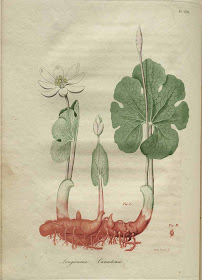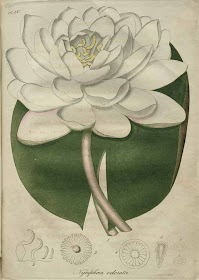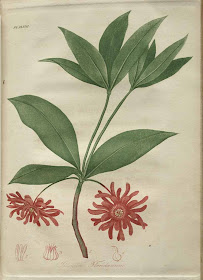In making the selection, I have endeavoured to be guided by positive evidence of important qualities and not by the insufficient testimony of popular report. . . I am by no means ambitious to excite an interest in the subjects of this work, by exaggerated accounts of virtues which do not belong to them. Much harm has been done in medicine, by the partial representations of those, who, having a point to prove, have suppressed their unsuccessful experiments, and brought in to view none but favorable facts." [Jacob Bigelow]

Rubus villosus (tall blackberry)

Sanguinaria canadensis (blood root)

Menyanthes trifoliata (buck bean)

Nicotina tabacum (tobacco)

Nymphea odorata - sweet scented water lily

Rhododendron maximum (american rose bay)

Illicium foridanum (starry anise)

Kalmia latifolia (mountain laurel)

Laurus sassafras (sassafras tree)

Liriodendron tulipifera (tulip tree)

Magnolia glauca - small magnolia

Apocynum androsaemifolium (dog's bane)

Datura stramonium (thorn apple)

Euphorbia ipecacuanha

Geranium maculatum (common cranesbill)

Ictodes foetidus (skunk cabbage)
Jacob Bigelow (1787-1879) graduated as a doctor but pursued a side interest in botany, that led him to publish the first systematic plant survey of the flora indigenous to Boston, in 1814.
In addition to his private practice and hospital medical work, Bigelow taught botany at Harvard University, where he was a Professor of both Materia Medica and Application of Science to the Useful Arts ('Technology', as he would come to call it, thereby giving the word its modern popular definition).
'American Medical Botany' was a landmark publication on a couple of fronts. The 3-volume work was issued between 1817 and 1820 and each book in the series evaluated twenty plants. The full page illustrations (almost all based on Bigelow's own drawings) for each species began as regular copper plate engravings with a team of colorists hand-finishing the work, as was the normal custom. But Bigelow was dismayed by either the time or the cost of such a labour intensive process and, calling on his own technological skills, modified the printing technique so that a few colours could be mechanically printed.
There are varying reports about the process adopted, ranging from a lithography stone etching technique to a modified intaglio printing method (the latter seems more plausible to me, considering the obvious plate marks around all the illustrations). Irrespective of the specifics, the series constitutes not only the first coloured botanical book illustrations, but the first colour plate-illustrated book of any kind in America.
"Bigelow brought a scientific depth and aesthetic pleasure not only to the subject of which he wrote and illuminated but also to the publishing and printing process itself. All these factors combine to make American Medical Botany rare in the broadest sense, beyond the mere scarcity of today’s physical copies."Among his many other accomplishments, Bigelow played a central role in the production of the first American pharmacopoeia in 1820; strongly influenced the behaviour of the medical profession through a series of lectures warning against the overuse and misuse of drugs and the dangers of archaic practices like bloodletting; and provided the designs for the first landscaped garden cemetery anywhere in America. If that isn't enough, he was also a founding Trustee of Massachusetts Institute of Technology, President of the American Academy of Arts and Sciences and a published poet.
- The best set of the 60-odd illustrations from 'America Medical Botany' are provided by the Rare Book Room, with the identical copy available from the earlier incarnation of Adobe's online rare book collections - Octavo Editions. I have slightly reduced the image sizes above to compensate for some digitisation anomalies. [Rare Book Room homepage - a fantastic resource if you haven't seen it]
- A very quick way to scan through all the illustrations is via NYPL, but these images are not nearly as good.
- 'Jacob Bigelow’s American Medical Botany: Digital Reissue Illuminates Access to Rare Work' by Steven Foster IN: HerbalGram. 2004;63:52-61 American Botanical Council, is definitely the best overall background read.
- Others: Harvard University; Bigelow Society; Stanford University.
- Amazingly, there is no wikipedia entry for Jacob Bigelow ... if anyone is feeling motivated (!?)
- IMPORTANT ADDITION (31.5.08): The University of Wisconsin have just digitised Bigelow's 'American Medical Botany' and this will now be the best source location to view the work.
You have the most exquisite eye! Thank you for posting these wonderful pictures. I check your blog each day for a new treat!
ReplyDelete